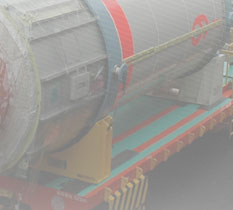 |
 |
||||
The advantage of M-V rockets comes from the fact that they are a collaborative effort between rocket engineers and satellite specialists. This is an ideal process for space development. It is not that a rocket is made first, and then a satellite whose specifications fit with the rocket is placed on board. The mission comes first, and we then develop each rocket bearing the mission objectives in mind. M-Vs are custom-made rockets designed according to the demands of scientific satellites. The top stages in particular are adaptable to different payloads. M-V rockets usually have three stages; however, a kick motor (a fourth stage) can also be added when necessary. That fourth stage and the satellite engine are the main components that are adapted to suit each specific satellite mission, while the fundamental base usually remains the same. The custom-designed launch vehicle for ASTRO-F is the M-V-8 rocket; the M-V-7 rocket is due to launch the solar physics satellite SOLAR-B. M-V rockets are capable of launching a 1.8-ton satellite into a low Earth orbit, but launching a planet explorer out of the gravity field is trickier, because it usually requires more power. The entire design of an M-V is optimized for its scientific mission. For example, for the purposes of orbit design, the rocket and satellite are thought of as one unit. The design takes both into account at every point, from the immediate post-firing of all four stages, to the explorer's separation from the rocket, to the firing of the explorer's own engine. Thanks to this perfect optimization, the M-V rocket can be used to launch a planet explorer of up to 500 kg. A unique characteristic of M-V-8/ASTRO-F is the attitude control of the rocket after it releases the satellite. A solid-propellant rocket accelerates slightly from the small amount of gas emitted by the embers of its fuel, which can cause the rocket to crash into the satellite after separation. In fact, such an accident has happened in the past. At the very least, to prevent such a collision, the attitude of the rocket must be controlled. But the M-V-8 mission carries an additional challenge: since ASTRO-F carries a sensitive infrared telescope, avoiding a crash is not enough; we need to make sure the rocket's gas emission does not reach the satellite. This is a very complicated maneuvre, but if the telescope gets clouded by the gas, it will be a serious problem, so very close attention has been paid to details, especially in the separation procedure. To sum up, M-V rockets have great flexibility to meet the demanding requirements of scientific missions. This is a very important feature, as each satellite mission has unique and complicated needs. We had a successful launch with the M-V-1 rocket in 1997, and in the following year with the M-V-3 rocket (the schedule of the M-V-2 launch is still unconfirmed). And when everyone was anticipating subsequent successes, an accident happened. The M-V-4, launched on February 10, 2000, had a problem with the first-stage motor and failed in launching the onboard X-ray astronomical satellite into orbit. This accident was caused by imperfect combustion of the rocket motor, which is a very fundamental problem. The whole JAXA organization focused on investigating the cause from various perspectives, such as the structure, material, thrust and control. Eventually we found that there was a structural problem in the nozzle throat of the first-stage motor, which could not withstand the high heat of 3000 At the same time, for performance improvement and cost reduction, we refitted the second stage with a high-performance motor with high-pressure combustion. During this process too, the nozzle material was damaged by high-pressure combustion, and a great deal of time was spent on finding a solution. About three years passed from the M-V-4 accident until the next launch, in May 2003, but the delay was not our primary concern. We wanted fundamental solutions to all the problems and thorough improvement for our rockets. With this motivation, the M-V-5 rocket, carrying the asteroid explorer Hayabusa, was successfully launched in May 2003. The next rocket, M-V-6, was also a success, launching the X-ray astronomical satellite Suzaku (ASTRO-EII) in July 2005. And this time, M-V-8 will be the third post-redesign rocket to be launched. With a successful launch, I think that, for the first time, we will be able to be proud of our achievements in improving the reliability of M-V rockets. The M-series rockets, whose development began with the pencil rocket, were developed in part for research and education. In the development of M-V rockets, the priorities have been performance and the pursuit of ever more efficient engineering technologies. Today, the development of M-V rockets has fundamentally come close to an end, almost reaching perfection, so I think now is the time to focus on further increasing reliability. Already, we have doubled the command systems, so the rockets can receive commands not with just one connection but two. I think we should continue to upgrade the components and circuits, for further improvements in reliability. |

|
||||
|
|||||
